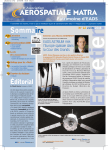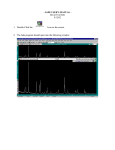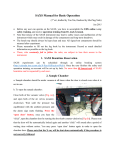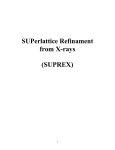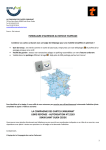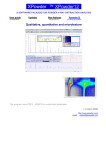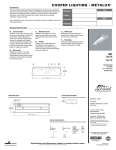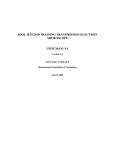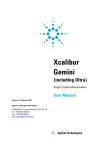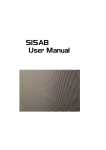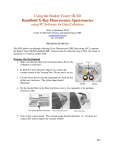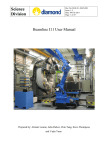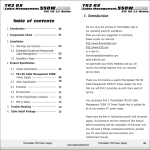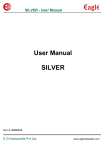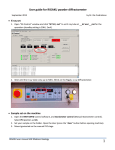Download X-ray multilayers optic
Transcript
X-ray multilayers optic User’s manual INEL . Z.A C.D 405 – 45410 ARTENAY & +33.(0)2.38.80.45.45 Æ 0+33.(0)2.38.80.08.14 ) [email protected] http://www.inel.fr S UMMARY PRESENTATION 1–2 EXAMPLES 3–4 SETUP 5 -10 1 – DESCRIPTION 2 – SETTING THE MECHANICS 2a – REMOVING THE MONOCHROMATOR MECHANICS 2b – SETTING THE MIRROR/MONOCHROMATOR MECHANICS 2c – DIFFERENTS KINDS OF SETUPS 2d – ADJUSTEMENTS 2e – MIRROR CHARACTERISTICS 6 6 -10 7 7 8 9 10 X-ray multiplayer optic – User’s manual Sheet 1/11 PRESENTATION X-ray multiplayer optic – User’s manual Sheet 2/11 Multilayers parabolics mirrors for x-radiation are comprised of nanometric stacks of alternating transparent and absorbent compounds. The mirror captures a wider solid angle of incoming beam than a standard flat germanium or graphite monochromator and its graded multilayers output a concentrated parallel beam. Results have shown that depending upon experiment type, for equivalent resolution and settings, intensities can increase by factors of 3 to 7 times. Figure 1 : Mirror mounted on the Inel diffractometer, located between the tube shield and monochromator housing. . The parabolic mirror does not offer Kα1 and Kα2 separation. We therefore have designed our system to be multifunctional. The mirror can be used by itself, or in combination with the flat germanium monochromator if an intense, pure Kα1 beam is desired. (See figure 1.) Parabolics mirrors have graded d-spacing designed to work with specifics wavelengths. X-ray multiplayer optic – User’s manual Sheet 3/11 EXAMPLES X-ray multiplayer optic – User’s manual Sheet 4/11 Figure 2 : Comparison of silicon standard data (SRM640b) with the direct beam (line 2), the filtered direct beam (line 3), and with the mirror (line 1). The experimental conditions were identical for the 3 measurements. With the mirror (line 1), the intensity is double that of the unfiltered direct beam (line 2). In line 1 only the Kα1 and Kα2 contributions are present whereas with the unfiltered direct beam, all energies in the copper spectra, Kα1, Kα2, Kβ give diffraction contributions. Using a nickel filter with the direct beam (line 3) similar resolution is obtained, but the intensity is 5 time less than with the mirror. Figure 3 : System comparison between setup with a germanium crystal alone vs. germanium crystal plus X-ray mirror in tandem. Silver behenate diffractograms, 1 mm diameter capillary, with mirror (black curve) and without the Xray mirror (red curve). Identical experimental conditions (monochromator Ge 111, 40 kV - 30 mA, Cu Kα1, spinning sample, 10 minutes acquisition time). An intensity gain of 3.5 is evidenced in this case. X-ray multiplayer optic – User’s manual Sheet 5/11 SETUP X-ray multiplayer optic – User’s manual Sheet 6/11 The Inel diffractometer equipped with the X-ray mirror, can beset belongs 3 differents possibilities: - mirror + monochromator, - mirror only, - monochromator only. The mirror is used as an intensifier of the primary beam, and is able to make parallel the primary beam (with 0.7 mm thickness). However, it is not able to separate kα1 and kα2. The monochromator is able to separate the kα doublet, to give a monochromatic beam, but decreases the intensity. It is the reason why that for high intensity and monochromatic beam, it is required to use the setup Mirror + Monochromator. When high flux is necessary, then the monochromator can be removed. The third setup is possible to do, but not interesting, because it corresponds to the first one with a low intensity. 1- DESCRIPTION Figure 4 : description of the optics 1 : 4 screws for adjusting the mirror 2 : Monochromator housing 3 : 2 fine screws to adjust the height of the pipe 4 : Crossed slits 5 : 2 screws to rotate the whole optics 6 : pipe 7 : Screws for holding the translation of the pipe 8 : Fine screw to adjust the tilt of the monochromator 9 : Fine screw to adjust the tilt of the mirror 10: Mirror housing 11: 2 screws to open the monochromator housing 12: 3 screws behind fixing the monochromator housing Figure 5 : Beam path and angles on the Inel diffractometer using the X-ray mirror, for the copper radiation 2- SETTING THE MECHANICS IMPORTANT : Each time user needs to dismount any mechanics, the power and the water cooling must be off. X-ray multiplayer optic – User’s manual Sheet 7/11 2a- REMOVING THE MONOCHROMATOR MECHANICS - Remove the cover of the monochromator, holding the crystal and rotation system, by loosing in S1. Remove the whole mechanics, by loosing attachment screws on the tube shield in S2. Be careful, the system is quite heavy. During the loosing the mechanical safety shutter must be jumped up [3]. Be careful to hold it during the procedure. Only the monochromator housing and the slits will be dismount to set on the mirror assembly. Slits are removed by loosing S4 Monochromator housing is dismounted by loosing the M4 screw (S5) defining the rotation axis, in rear. The pipe is dismounted as following scheme. - S6 allow to loose the "tube shield interface. It is necessary to remove the "rear cover". Instead of the " tube shield interface" will be set the "mirror pipe". In the next part are described the several possibilities of configuration. In case of it is necessary to remove the crystal itself, loose the S8 screws on the side. 2b- SETTING THE MIRROR/MONOCHROMATOR MECHANICS - - - Attach "A" the optics holder on the tube shield, with S2 screws. Before tightening the plate, set the "tube shield interface" and the " mechanical safety shutter" [3]. Attach the "mirror housing" "B", by screwing S9. Attach the part "C" (Monochromator housing and slits system), with "S5" in "H1". Take care to introduce the mirror pipe on the "Monochromator housing" Fix the slit on the new pipe assembly in S4. Rear side of "C" part: The screw on H2 must fix : in "I" if the mirror only is used, or in "II" if the assembly mirror/monochromator is used X-ray multiplayer optic – User’s manual Sheet 8/11 2c- DIFFERENT KIND OF SETUP Figure 6 : Mirror + monochromator setup. The angle between the beam coming from the mirror, and the beam exiting to the monochromator is 27.28°. This angle is fixed by using 3 screws (ref.12 on fig.4) : - 1 screw for the axis of the monochromator housing 1 screw maintaining the arm 1 handled screw to remove when we wish to switch from one mode to the other. There are only 2 positions allowed : straight or inclined at 27.28°. Figure 7 : Mirror setup without monochromator. The Germanium crystal must be removed from the monochromator housing. The pipe and the mirror surface must be on the same alignment (+/- 1.5°). For this feature, we must use the handled screw behind. It must be removed, to fixed the arm to the straight position. Figure 8 : Monochromator only This setup can be done, but it is not very interesting, because it is like the case of Mirror + monochromator, but with less intensity. Then mirror housing must be removed, and replaced the monochromator housing. A pipe extension is available to increase the pipe size. The angle between the source and the pipe, must be 27.3°. X-ray multiplayer optic – User’s manual Sheet 9/11 2d- Adjustements 2da- The mirror The mirror can be aligned by using the screws 1 (S1) and the micro-screw 9 (MS9) (figure 4). We usually need the MS9. S1 are used for adjusting the horizontally. MS9 is used for tilting the mirror, in order to get the reflected beam. To adjust it, it is required to remove the monochromator housing cover (using 11), and replace it with the cover containing the fluo-screen (see tool box). When it is fixed, put X-ray on, and check with a counter that everything is safe. Turn MS9, to see the 2 differents beams : at low incidence (on the top-left of the fluoscreen) the direct beam must be seen. By turning MS9, it must disappeared and the reflected beam must appears at 1.15° of incidence (The print must be displaced to the bottom right). When the print of the reflected beam is selected (figure 9–3), switch off the X-ray, and replace the fluo-screen cover by the Germanium holder. Refers to the monochromator adjustment for the second part. Figure 9 : Prints appearing when MS9 is rotated counter clockwise. (1) is the full direct beam (top), (2) are prints of direct beam (top) and weak reflected beam (bottom), (3) the full reflected beam. 2db- The monochromator Put the fluo-screen on the fixed sample holder, in order to see the beam coming through the slits. Open in large the vertical slit. Switch on X-rays. Turn the MS8 on the monochromator housing until the beam is found. The different steps of the adjustment are described in figure 10. The best adjustment correspond to the scheme (3). Figure 10 : Prints appearing when MS8 is rotated counter clockwise. (1) is the beginning of k α2, (2) is fully kα2 with a small amount of kα1, (3) is fully kα1, and (4) is a ended part of kα1. Then the beam must be adjusted as (3). 2dc- Centering the beam between the slits The following procedure is to close gradually the slit (Fv), and check that the beam is not "cut" by the slit. If it is the case, move slightly up and down the pipe in order the center the beam on the slit axis. 2dd- Centering the whole optics on the diffracting axis Please refers to the chapter : ALIGNING THE DIFFRACTOMETER and follows the section “Centering the optics on the diffracting axis “ 2e- Mirror characteristics X-ray multiplayer optic – User’s manual Sheet 10/11 Mirror characteristics: Focal distance Dimensions (L x l x e) Incidence angle Outcoming beam width Capture angle d-spacing range Average reflectivity FWHM of rocking curve 100mm 40 x 20 x 10mm 1.15° 0.85mm 0.54° 32.9 – 40.3 Å 65 ± 5 % 0.042 à 0.075° X-ray multiplayer optic – User’s manual Sheet 11/11












